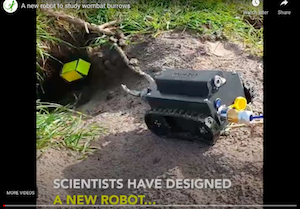When scientists describe new species of animals, they usually collect specimens from the wild. They kill the animals and preserve them in chemicals or with other methods. They take them back to a lab or museum so that they and other scientists can study them.
Euthanizing (killing) animals to study them is not always the best approach. What if the animal is a rare or threatened species? What if the animal you are holding is one of the few remaining on the planet?
Conservationist and photographer Scott Trageser has developed a 3D scanning system that might help solve this problem. His system uses a group of cameras that work in sync to rapidly capture photos of animals in the wild. These cameras create a virtual 3D specimen that is viewed on a smartphone or with a virtual reality headset.
Imagine you’re leading an expedition in the depths of a forest. You discover a species of frog that captures your interest. Instead of capturing the frog, euthanizing it, and taking it back to a lab or museum, you can use the 3D technology. You can create a 3D, high-resolution, true-to-life virtual model of the creature.

A 3D rendering of a turtle captured by Scott Trageser in Ecuador. The noninvasive methodology developed by Trageser will enable scientists to conduct research without euthanizing animals. Image courtesy of Scott Trageser
The 3D scanning system looks a lot like a photo studio that puts animals in the spotlight. It consists of a group of cameras that are connected to one another through a control box. Once the team captures an animal, they place it in the middle of the system. The cameras are all synced to take photos at the same time. They click rapid bursts of photos, usually in less than 5 seconds.
“I manually rotate it around because we don’t want motors making any noise,” Scott Trageser said. “We do the dorsal [back] scan first and take about 100 photos, and then flip the animal over for another 100 photos of the ventral [front] side.”

A species of frog scanned in the Ecuador by Scott Trageser. Image courtesy of Scott Trageser
Scott Trageser did a trial expedition in Panama with the technology. He then tried it out in the Rio Manduriacu Reserve in Ecuador. Trageser and his team have used the 3D system to create digital specimens of 12 species found in Panama and Ecuador, including frogs such as Nymphargus balionotus and Atelopus longirostris.
Keeping the animals still, even for a few seconds, is one of the biggest challenges of using the 3D technology. A slight tremor or a quick blink from the animal are enough to ruin the photos. That forces the team to start scanning from scratch. Trageser said he’s come to realize that each individual animal has quirks that can keep them still just long enough to get the needed scans.
For instance, in Rio Manduriacu, the team was having trouble getting a glass frog to stay still. Trageser then realized that if he placed a droplet of water on the frog’s eyeball, it would blink and then stay still for a few seconds. “It was like being a frog whisperer,” he said.
In some ways, however, having a virtual specimen is no substitute for having a physical one. For one, it’s not possible to study an animal’s internal morphology (body parts). Nor can researchers take a scanning electron microscope to the animal’s skin or look into its retina.
Also the high cost and technical skills required to assemble and operate the 3D system are hurdles to it being used more widely.
Scott Trageser said he’s currently working to make a version of the technology that is cheaper and easier to use than the first model. He is planning more expeditions to further perfect the methodology and experiment with it.
David Brown adapted this story for Mongabay Kids. It is based on an article by Abhishyant Kidangoor, published on Mongabay.com:






